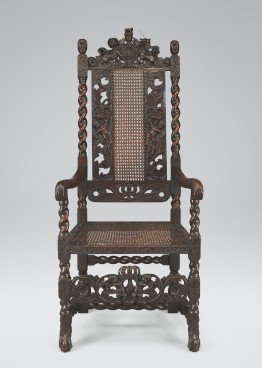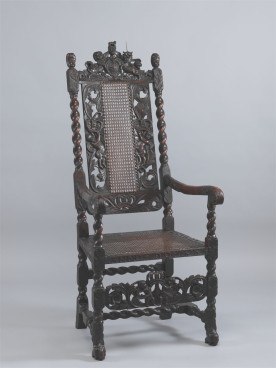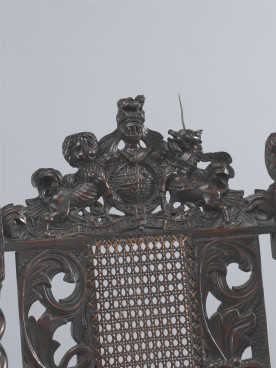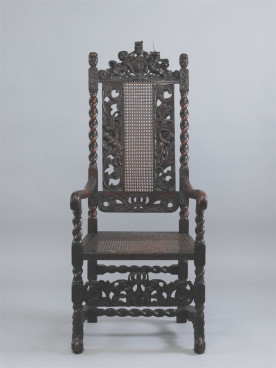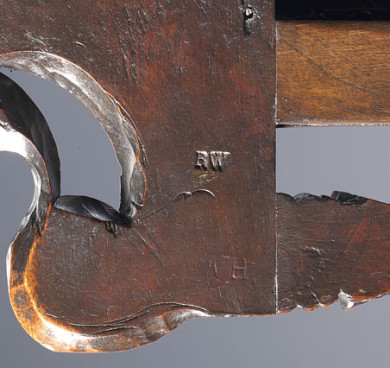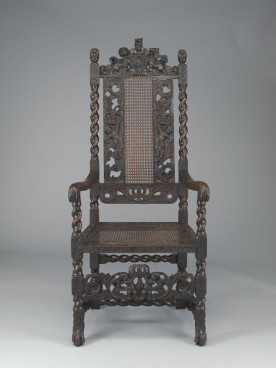Armchair, c.1688
Walnut and cane
The crest bears the royal stuart coat of arms. The seat rail is carved with the inscription ‘GEORGE LEWIS—FEBVERY 20—ANNO DO—1687/8’. It was formerly in the collection of the antiquarian George W. Braikenridge (1775–1856) of Broomwell house, Brislington, near Bristol.
Victor Chinnery Catalogue
Description
A walnut and cane armchair, the cresting formed as a carved and pierced royal coat of arms flanked by boy’s-head finials, the back with a single panel of cane held between slats carved with boys and crowns and with the monogram GL, flanked by twist-turned uprights, the cane panel seat within a frame carved with the legend GEORGE LEWIS FEBVERY Ye 20 ANNO DO 16878, flanked by scrolled arms with leafy and floral carving with rosette fore-ends and raised on twist-turned supports, the low fore-stretcher pierced and carved with boys supporting a crown, raised on twist-turned legs united by twist-turned H-stretchers, the legs extended to form hairy three-toed lion’s-paw feet.
English, London, dated 1687/8
Dimensions
H: 53½in W: 22½in D: 24in
Condition
Generally excellent. The crest-rail now backed by a laminated board for support. The Unicorn supplied with a replacement pewter horn. The caning to the seat replaced and the seat-rails patched and strengthened. Brass plates added to the base of the feet.
Provenance & References
Ex-coll. George Weare Braikenridge, Brislington, Bristol, 1775-1856.
Sold by Christie’s, London, 25 June 1931, Lot 53.
Illustrated in Christie’s Review of the Year 1931, p. 312.
Exhibited CINOA International Art Treasures Exhibition 1962, Victoria & Albert Museum, Exhibit No. 70 (the property of S W Wolsey, London).
Ex-coll. Mr & Mrs J Edgar Stone, 1966.
Illustrated by RWP Luff, Some Chairs and their Personal Associations, in The Antique Collector Magazine, December 1966, p. 257, Figs. 7 & 8.
Sold by Sotheby’s, New York, 8 December 1989, Lot 472.
Illustrated in The Art Quarterly (National Art Collections Fund) Spring 1990.
Purchased from R A Lee (Fine Arts), 15 June 1990.
Illustrated by Adam Bowett, English Furniture 1660-1714, p. 92, Plate 3:41.
The inscription may relate to George Lewis, who became Elector of Hanover in 1698 and subsequently, as George I (1714-27), the first Hanoverian king of Great Britain and Ireland. Further research is necessary to establish whether this supposed connection is correct, and to investigate any significance of the date February 20 1687/8 in the biography of George I.
Comments
George Weare Braikenridge, a very active antiquarian collector of Broomwell House, Brislington (now a suburb of Bristol) was drawn sitting in this chair in c.1832 (see Sheena Stoddard, Mr Braikenridge’s Brislington, City of Bristol Museum & Art Gallery, 1981, frontispiece). Much of his collection was sold by Christie’s in 1908, the most famous item of furniture being the so-called cradle of Henry V, which was bought by Edward VII and has since 1911 been on loan to the Museum of London (see Victor Chinnery, Oak Furniture – The British Tradition, Woodbridge 1979, pp. 397-8, Fig. 3:470).
Baroque

